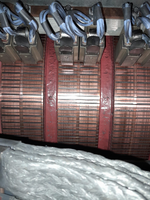Probable causes:
1) Incorrect brush alignment / off neutral. This can be because of the physical positioning of the brush contact face relative to the commutation zone, or it can be a result of dissymmetry in the magnetic field (interpole or main pole winding is exhibiting shorted turns, usually).
2) Incorrect interpole strength. Again, a "shorted turn" result, OR a mix-up in the sequencing of the shim pack between the interpole body and the frame cylinder. Most manufacturers recommend having magnetic material near the frame and nonmagnetic material near the pole body. it can also be a result of having the wrong (or at least different) air gaps between interpoles and armature surface.
3) Inappropriate brush grade. Brush is not capable of carrying the required current density, resulting in arcing as the bar leaves the brush face (so for argument purposes, the original post photo means the comm surface should be moving from top to bottom).
4) Low spring pressure. As brush meets the bar edge (in this case, surface moving from bottom to top), the edge of the bar causes the brush to "jump" away from the surface. Insufficient spring tension means the brush loses contact - creating an arc to the bar. The localized heating from the arc eventually destroys the film, appearing as a "burn" mark.
5) Sparking from some contamination. This may be airborne (chemical or moisture), particulate, or something embedded in the brush itself. Bottom line - it requires a larger voltage to "push" current across the brush-to-bar film - which in turn means a higher chance for arcing and eventual burning.
Just so you know - the burn is a direct result of an electrical arc producing erosion of the film (and, if allowed to progress far enough, the bar itself). It may be under the brush a bit, instead of the "streamers" right at the edge that you might have been expecting. But it is present.

